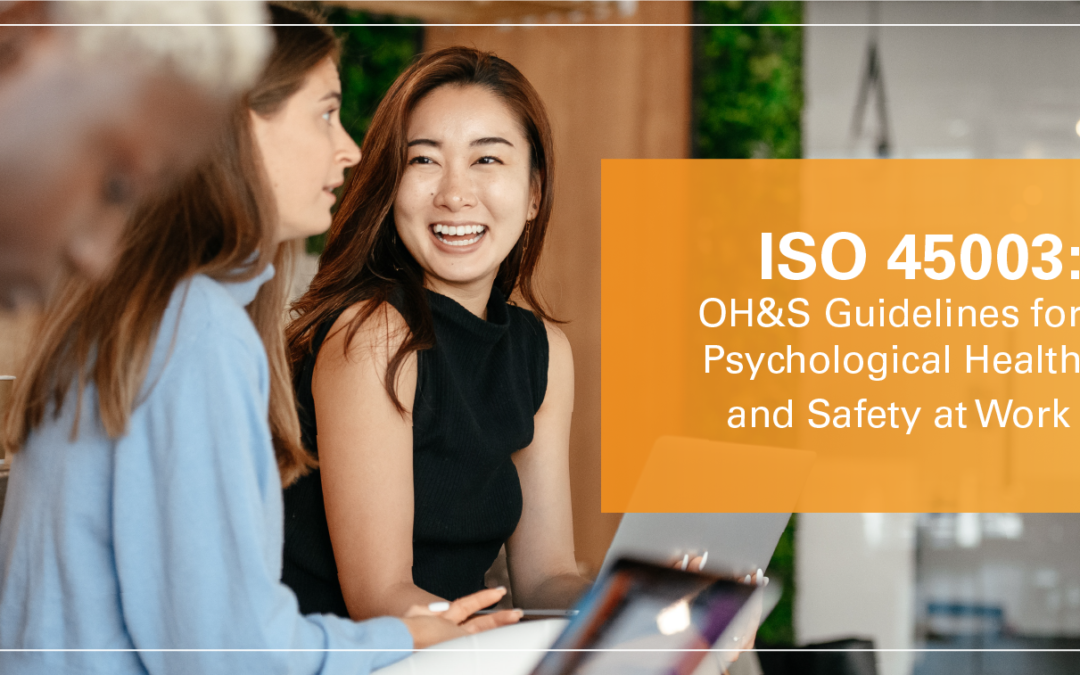ISO 45003: OH&S GUIDELINES FOR PSYCHOLOGICAL HEALTH AND SAFETY AT WORK
What is it and what does it mean for your organisation?
Work can have a significant impact on all aspects of wellbeing. The COVID-19 pandemic has highlighted just how great this impact can be, particularly for mental and psychological health and wellbeing. It’s important for employers to recognise that they have a responsibility to protect both the physical and mental health of their staff.
In June this year, The International Organisation for Standardisation (ISO) published the world’s first International Standard to address mental health in the workplace.
ISO 45003, Occupational health and safety management – Psychological health and safety at work – Guidelines for managing psychosocial risks, gives guidance on managing psychological health and safety risks within an organisation.
The standard addresses that, in the same way that any company needs to manage physical hazards in the workplace, psychosocial hazards should also be managed, as part of an occupational health and safety (OH&S) management system.
Where OH&S once mostly applied to sectors with physical risks to their employees – such as hospitality and construction – psychosocial hazards can be present in all organisations and sectors, from all kinds of work tasks.
ISO defines psychosocial risks as risks that affect psychological health and safety, as well as health, safety and wellbeing at work more broadly. There are a range of terms that are used in relation to what psychosocial risks affect, including ‘psychological health’ and ‘mental health’.
Psychosocial risks can include factors related to work design such as workloads, deadlines, the type of work, isolation and work-life balance. It also includes social factors within an organisation such as culture, workplace relationships, bullying, harassment, fairness, and even career development.
Effective management of psychosocial risk can lead to benefits such as improved worker engagement, enhanced productivity, increased innovation and organisational sustainability.
The standard addresses a range of areas that can impact an employee’s mental health, including ineffective communication, excessive pressure, poor leadership and organisational culture.
Here are three measures for addressing and eliminating psychosocial hazards at work, as recommended by ISO:
1. Redesign work processes
In many cases, controlling psychosocial risks within an organisation will require the redesign of work processes. Measures can include increasing employees’ control over the way that they work, such as flexible hours and job sharing. It can also include encouraging breaks to manage fatigue, restricting work-related contact outside of working hours, and providing practical support during peak workload periods.
2. Provide education and support for employees
Measures for controlling social risks include increasing awareness of psychosocial risks and providing education for employees on how to report them, establishing support measures for workers who are experiencing negative psychological health impacts from work, and regularly recognising and showing appreciation for the hard work and dedication of employees.
You can also manage risks by providing access to, or information about, support services, as well as improving workplace culture through a range of integrated programs such as employee assistance programs.
3. Promote wellbeing at work
Promoting the wellbeing of employees at work is vital for fulfilling their physical, mental, social and cognitive needs and expectations in relation to their work. Wellbeing at work relates to all aspects of working life and can also contribute to an employee’s quality of life outside of work.
You can promote wellbeing in the workplace by implementing physical health programs or challenges, providing mental wellbeing resources, mindfulness practices, personal development opportunities, and more. It’s important that you assess the levels of wellbeing within your organisation, so that you can act on improvements that matter.
Springday can help you to assess your organisational wellbeing needs and evaluate employee wellbeing and engagement to develop a tailored wellbeing strategy for your workforce. Our tailored platforms help to promote wellbeing through curated monthly campaigns, resources from wellbeing experts and wellbeing assessment tools.
Help your employees manage stress, find better work-life balance, and boost their overall wellbeing with a comprehensive digital wellbeing platform by Springday. Learn more about our solutions or chat to us about how we can help you.










